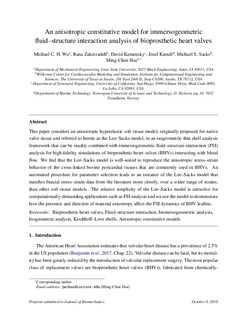| dc.contributor.author | Wu, M.C.H. | |
| dc.contributor.author | Zakerzadeh, R. | |
| dc.contributor.author | Kamensky, David | |
| dc.contributor.author | Kiendl, Josef | |
| dc.contributor.author | Sacks, Michael | |
| dc.contributor.author | Hsu, Ming-Chen | |
| dc.date.accessioned | 2018-12-17T14:54:12Z | |
| dc.date.available | 2018-12-17T14:54:12Z | |
| dc.date.created | 2018-04-24T17:52:54Z | |
| dc.date.issued | 2018 | |
| dc.identifier.citation | Journal of Biomechanics. 2018, 74 23-31. | nb_NO |
| dc.identifier.issn | 0021-9290 | |
| dc.identifier.uri | http://hdl.handle.net/11250/2577982 | |
| dc.description.abstract | This paper considers an anisotropic hyperelastic soft tissue model, originally proposed for native valve tissue and referred to herein as the Lee–Sacks model, in an isogeometric thin shell analysis framework that can be readily combined with immersogeometric fluid–structure interaction (FSI) analysis for high-fidelity simulations of bioprosthetic heart valves (BHVs) interacting with blood flow. We find that the Lee–Sacks model is well-suited to reproduce the anisotropic stress–strain behavior of the cross-linked bovine pericardial tissues that are commonly used in BHVs. An automated procedure for parameter selection leads to an instance of the Lee–Sacks model that matches biaxial stress–strain data from the literature more closely, over a wider range of strains, than other soft tissue models. The relative simplicity of the Lee–Sacks model is attractive for computationally-demanding applications such as FSI analysis and we use the model to demonstrate how the presence and direction of material anisotropy affect the FSI dynamics of BHV leaflets. | nb_NO |
| dc.language.iso | eng | nb_NO |
| dc.publisher | Elsevier | nb_NO |
| dc.rights | Attribution-NonCommercial-NoDerivatives 4.0 Internasjonal | * |
| dc.rights.uri | http://creativecommons.org/licenses/by-nc-nd/4.0/deed.no | * |
| dc.title | An anisotropic constitutive model for immersogeometric fluid-structure interaction analysis of bioprosthetic heart valves | nb_NO |
| dc.type | Journal article | nb_NO |
| dc.type | Peer reviewed | nb_NO |
| dc.description.version | acceptedVersion | nb_NO |
| dc.source.pagenumber | 23-31 | nb_NO |
| dc.source.volume | 74 | nb_NO |
| dc.source.journal | Journal of Biomechanics | nb_NO |
| dc.identifier.doi | 10.1016/j.jbiomech.2018.04.012 | |
| dc.identifier.cristin | 1581373 | |
| dc.description.localcode | © 2018. This is the authors’ accepted and refereed manuscript to the article. Locked until 12.4.2019 due to copyright restrictions. This manuscript version is made available under the CC-BY-NC-ND 4.0 license http://creativecommons.org/licenses/by-nc-nd/4.0/ | nb_NO |
| cristin.unitcode | 194,64,20,0 | |
| cristin.unitname | Institutt for marin teknikk | |
| cristin.ispublished | true | |
| cristin.fulltext | postprint | |
| cristin.qualitycode | 2 | |

